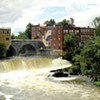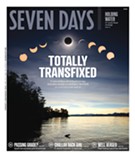Tuesday, March 11, 2014
What I'm Watching / Film / Movies What I’m Watching: Betty Boop in ‘Snow White’ (1933)
Posted
By Ethan de Seife
on Tue, Mar 11, 2014 at 2:17 PM
One career ago, I was a professor of film studies. I gave that up to move to Vermont and write for Seven Days, but movies will always been my first love. In this feature, published occasionally here on Live Culture, I'll write about the films I'm currently watching, and connect them to film history and art.
In preparation for an essay that I’ve been asked to write for a film journal, I’ve recently returned to a film that I’ve seen many times before, and it’s one that never fails to instill in me a mighty sense of “HUH?” It’s an animated version of Snow White, but not the famous Disney version from 1937; this one predates Disney’s epochal film by four years, and features Fleischer Studios’ sauciest leading lady, Betty Boop, in one of her weirdest star turns.
The occasion for my return to this film is that this particular journal will soon publish a special issue on “Bizarre Films,” and the 1933 Snow White is a gold-medal winner in bizarreness.
Informed that I could write about any bizarre film I wished, I thought for weeks about which to choose, rejecting such obvious options as Otto Preminger’s Skidoo, almost anything by Alejandro Jodorowsky and Fernando Arrabal’s rather remarkable 1971 film Viva la Muerte (a showing of the last was the occasion of one of my first dates with my now-wife; make of that what you will). I didn’t want to write about these or other films that seemed to cultivate strangeness, even as, generally speaking, I welcome that artistic gesture. Rather, I wanted to write about a “normal” film that has a current of strangeness coursing through it.
In animation circles, Fleischers’ Snow White is well-known as an oddity, so I’m not breaking new ground here. But it seems to me that this 80-year-old film has slipped through the cracks; even many lovers of animation don’t know about it, so it seemed ripe for revisiting. (I'm also happy to note that this is the first "What I'm Watching" film that is available on YouTube, so you can watch it below.)
)
As an aside, the reason for the film’s relative obscurity — and for the fairly low level of cultural currency that Betty Boop seems to have these days — may have something to do with the fact that there had never been an official, high-quality DVD release of any of the Betty Boop films. Until last year. The first two volumes of a planned four-volume DVD / Blu-Ray Betty Boop collection were released in 2013 by Olive Films, a good, small-label video company. Before these discs, the historically important and pretty terrific Boop films were available only in lousy, cut-rate DVD editions that used old kinescopes for source material. Even the Olive Films Boop discs that have been released, though, don’t include Snow White, which to me is an oversight. This is a major film, largely because it is so majorly weird.
To take it back even further: The reason that the Betty Boop films were available only on crummy, public-domain releases has to do with the now-defunct Fleischer Studios’ legacy of irresponsible business practices. It’s too much history to delve into here, but suffice it to say that the Fleischers’ strength was technically proficient, sometimes trendsetting animation. But they achieved these advances at the expense of focusing on, you know, running their studio.
Poor business decisions in the 1930s and ’40s rippled through the decades, bringing about a situation in which, as I understand it, the copyright statuses of many Fleischer films remained in limbo for a long while. Many films lapsed into public-domain status, which accounts for that preponderance of poor-quality DVDs of Betty Boop films.
In searching for a suitably bizarre film, I briefly entertained the notion of writing about the 2008 Katherine Heigl romantic comedy 27 Dresses. Not because it’s actually bizarre, but because it is so relentlessly, aggressively average that it achieves hitherto unreached levels of mediocrity. It's a quality that is, in its own bizarre way, bizarre.
I rejected that idea (you’re welcome), but Snow White does share one important quality with 27 Dresses: Both were made by major studios and widely released to mainstream audiences. Unlike Jodorowsky’s or Arrabal’s films, which were intended for self-selected “artsier” audiences, Snow White was unleashed upon an unsuspecting populace several decades before the widespread availability of LSD would have allowed them to enjoy it fully.
There’s almost nothing that’s not odd about the Fleischers’ version of Snow White. Most obvious is the way that it plays fast and loose with the narrative of the original fairy tale. The film retains only a few of the most obvious elements of the tale’s story — the evil queen consulting her magic mirror, the presence of the seven dwarves, Snow White herself in a state of suspended animation in a glass coffin — but they’re included solely as signposts. That is, these story elements don’t really have narrative ramifications, they just exist as a way to namecheck the fairy tale. The queen doesn’t scheme to give Snow White the poison apple; the seven dwarves do nothing in the film besides sled down a hillside, and Snow White is not awakened from her slumber by a prince (or by anybody else — she just sort of wakes up when a cloud of magic smoke passes by). As a result, the film cannot really be said to tell the story of Snow White but merely to refer to it.
As in so many of their other cartoons, in Snow White the Fleischers pay little mind to narrative cohesion because they’re focusing so intently on their animation technique. And the animation is superb. Like other Fleischer films, Snow White was animated “on ones”: one drawing for every frame of film, or 24 drawings per second. The artistic result of this process is an animation of smooth, flowing movements; the economic result of this process is eventual madness and financial ruin. Twenty-four drawings per second is a LOT of drawings: more than 10,000 for this seven-minute film. Many an animator was driven crazy by these demands, and Fleischers’ studio wasn’t the only one to suffer from the financial toll it took.
The characters in the film do move with uncommon grace and ease, but the animators use this grace indiscriminately. Betty boops across the screen with curvaceous glee, but so do a couple of talking icicles, twisting themselves in sinuous curlicues. Those icicles, whose very presence is odd and incidental, compete with the main characters for our visual attention.
In fact, the film is crammed with little one-off jokes that bear no relation to the story. A perfect example is when the queen’s face, by dint of is graphic resemblance to a long-handled frying pan … turns into a frying pan. It’s not even really a gag; it’s just an out-of-nowhere visual gesture. The film has so many such gestures that it almost collapses under the weight of its own visual cleverness.
But I haven’t even mentioned yet the most bizarre moment in Snow White: the roughly two-minute-long musical sequence in which Koko the Klown (another recurring Fleischer character who inexplicably accompanies Betty Boop in this film) is transformed into a ghost who sings with the voice of Cab Calloway — really. Ghost-Koko lip-syncs to Calloway’s famous recording of “St. James Infirmary Blues" because … the Fleischers apparently licensed the song for inclusion in this film. Neither the lyrics of the song nor Ghost-Koko’s performance of it have anything to do with the narrative of Snow White.
This little musical number does, however, provide numerous occasions for bizarre occurrences. At one point, the ghost’s head turns into a bottle of liquor, a shot of which the ghost pours into a shot glass, the contents of which he then tosses into his neckhole before the bottle becomes his head again and reattaches itself. Oh, and occasionally there’s a flying, top-hatted skull and some sort of skeleton bird flying around in the background.
That all happens just before a tiny duck protrudes from the queen’s magic mirror, and a puff of smoke turns her into a dragon. After chasing Betty, Koko (no longer a ghost) and Bimbo the dog (another recurring Fleischer character) to the tune of “Hold That Tiger,” that dragon — which occasionally sprouts three honking ducks from its head — is turned into a skeleton creature when Bimbo yanks on its tongue and turns it inside out. Then our three ostensible heroes dance a jig in the snow for a couple seconds, and the film ends.
In this Snow White, very few events occur for a reason. Anything can happen at any time, and they are presented in an animation style that goes out of its way to emphasize its own unusualness. All of which adds up to a film that may not make sense, but, for its many confusing oddities, benefits from multiple viewings. I’ve probably seen this film more than 30 times, and it doesn’t make any more sense to me now than it did upon my first viewing — and that’s exactly why I like it.
Comments
Showing 1-1 of 1
Comments are closed.
Since 2014, Seven Days has allowed readers to comment on all stories posted on our website. While we’ve appreciated the suggestions and insights, the time has come to shut them down — at least temporarily.
While we champion free speech, facts are a matter of life and death during the coronavirus pandemic, and right now Seven Days is prioritizing the production of responsible journalism over moderating online debates between readers.
To criticize, correct or praise our reporting, please send us a letter to the editor. Or send us a tip. We’ll check it out and report the results.
Online comments may return when we have better tech tools for managing them. Thanks for reading.
One or more images has been removed from this article. For further information, contact
[email protected].













































